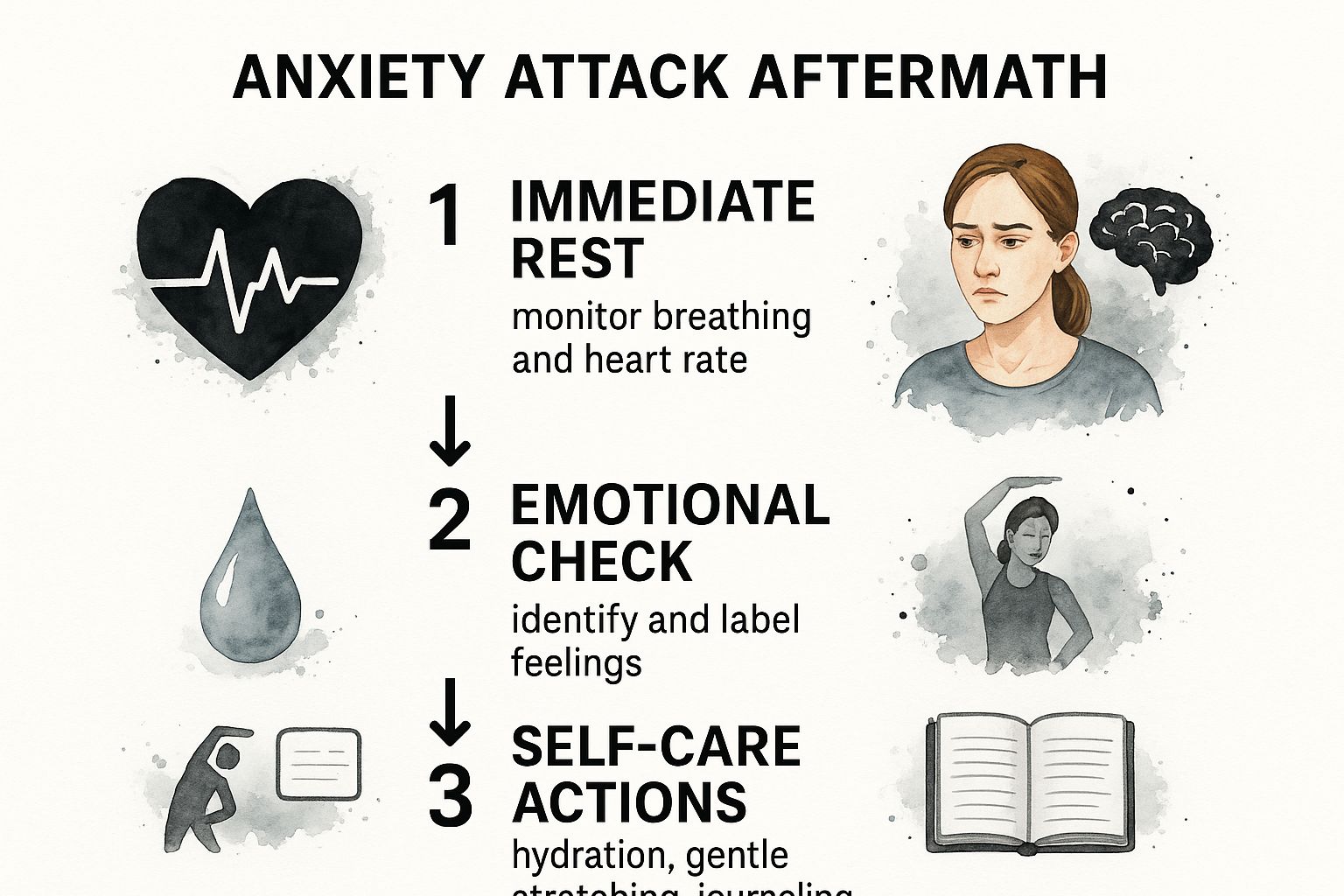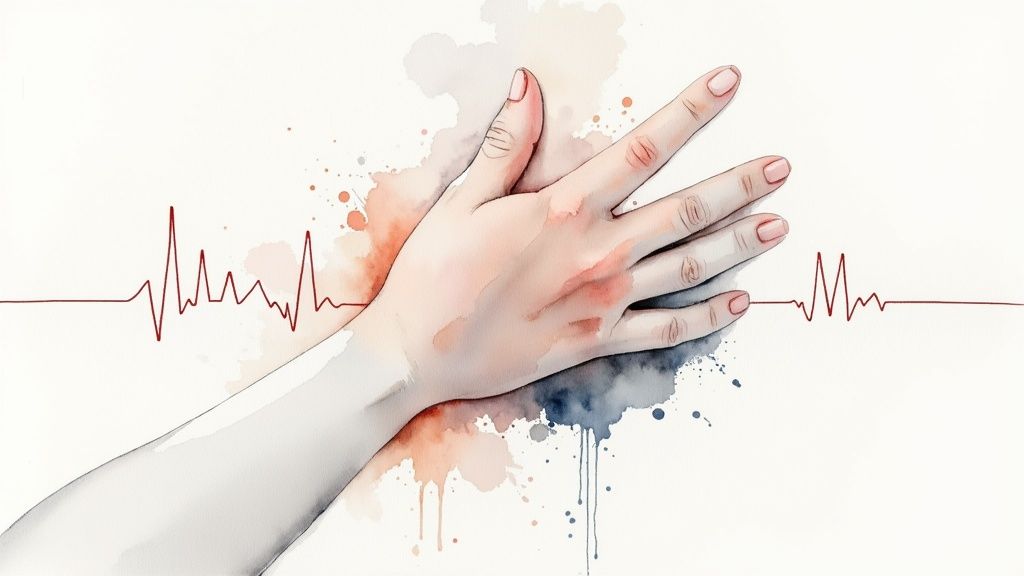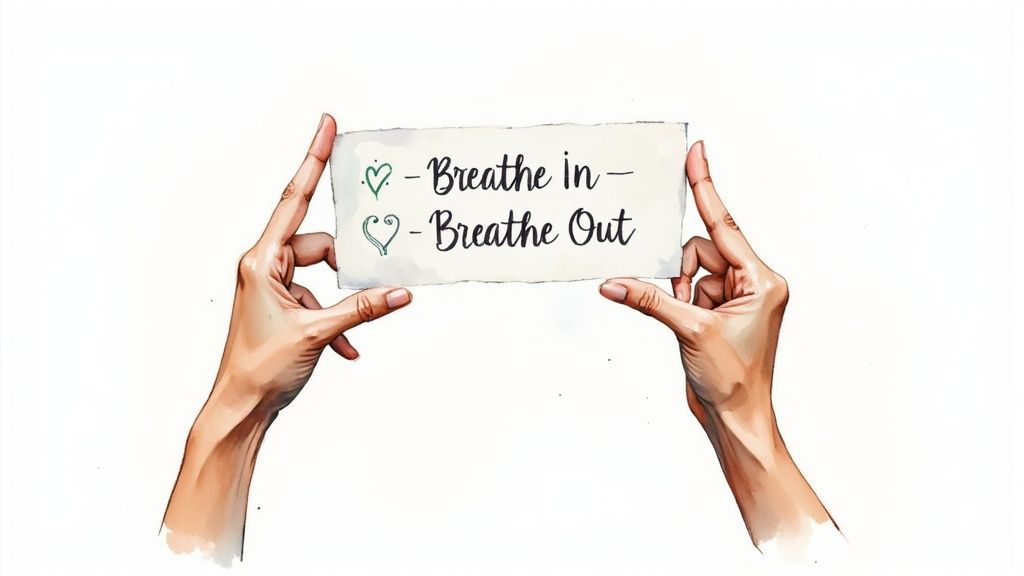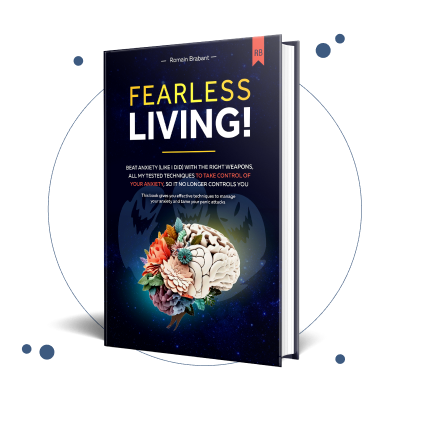
The anxiety attack aftermath can feel like a strange, disorienting "panic hangover." You’re left feeling physically wiped out and emotionally fragile, almost like you’ve run a marathon you didn't sign up for. This isn't just in your head—it’s a very real physiological response to the intense surge of stress hormones your body just went through.
Knowing what’s actually happening inside your body can make all the difference. It allows you to shift from confusion to compassion and start taking gentle, immediate steps to help yourself heal. Most importantly, it's the first step on a clear path toward a life free from panic.
Understanding the Panic Hangover
When a panic attack strikes, your body flips a switch on its ancient survival system—the fight-or-flight response. This mechanism floods your system with adrenaline and cortisol, prepping you to handle what it perceives as an imminent threat. Your heart pounds, your breathing gets shallow and fast, and every muscle in your body tenses up. It's a massive, full-body expenditure of energy.
Once the perceived danger is gone and the attack subsides, your body is left completely depleted. Those stress hormones don't just vanish; they take time to return to normal levels, leaving a trail of physical and emotional symptoms in their wake. This isn't a sign of weakness. It's simply your body recovering from an incredibly intense biological event. You can dive deeper into the mechanics of this in our complete fight-or-flight response guide.
This visual breaks down the initial recovery phase into simple, actionable steps.

As you can see, the path forward is straightforward: first, allow for immediate rest. Then, gently check in with how you’re feeling. Finally, engage in simple self-care actions that support your nervous system as it comes back into balance. Each step is a move toward healing and strength.
Common Feelings After an Attack
While the aftermath is different for everyone, many people report a similar cluster of feelings. Recognizing these can help you feel less alone and more in control of your recovery.
- Profound Fatigue: You might feel an overwhelming sense of exhaustion, as if you have absolutely no energy left. That’s because, biologically, you just used a massive amount.
- Muscle Aches and Pains: All that intense muscle tension during the panic can leave you feeling sore and stiff, especially in your neck, shoulders, and back.
- Mental Fog or Detachment: It’s common to feel a bit disconnected from your surroundings, a sensation known as depersonalization. Your thoughts might feel sluggish or fuzzy as your brain recovers.
- Emotional Vulnerability: After the intense fear fades, you might feel raw, weepy, or unusually irritable. Your emotional defenses are down, leaving you much more sensitive than usual.
It’s so important to remember that this recovery period is a testament to your body's strength, not a failure. Allowing yourself grace and time to heal is the first and most crucial step toward feeling like yourself again.
Taking Gentle First Steps
Instead of feeling lost in the haze, you can take small, deliberate actions to ground yourself and signal to your body that the danger has passed.
A great way to get started is with a simple, focused checklist. The goal isn't to accomplish a long list of tasks, but to gently guide your body back to a state of calm.
Your Immediate Post-Attack Recovery Checklist
| Action Item | Why It Helps | Simple First Step |
|---|---|---|
| Sip Water | Rehydrates your body after the intense physical response of a panic attack. | Pour a small glass of cool water and take slow, deliberate sips. |
| Find a Safe Space | Signals to your nervous system that the threat is gone and it's safe to relax. | Move to a quiet room, your favorite chair, or even just turn down the lights. |
| Gentle Breathing | Helps regulate your heart rate and calm your overstimulated nervous system. | Place a hand on your belly. Notice it rise and fall without trying to change it. |
| Light Snack | Stabilizes blood sugar, which can dip after the energy expenditure of an attack. | Grab something easy like a banana, a handful of nuts, or a piece of toast. |
| Wrap in a Blanket | The gentle pressure and warmth can have a deeply soothing, grounding effect. | Grab a soft blanket and wrap it snugly around your shoulders. |
This isn't about pushing through; it's about gentle care. With each small step, you are not just recovering—you are actively building resilience and proving to yourself that you know how to guide your body back to safety. You've got this.
The Lingering Impact of Panic Attacks

A panic attack is more than just a few minutes of intense fear. Its effects can ripple through your life long after the storm has passed. Understanding this aftermath is a crucial step toward healing because it validates the very real consequences you might be feeling.
This isn't just about feeling shaken up for an afternoon. The experience of intense panic can fundamentally change your relationship with your own mind and body. It leaves behind a powerful, negative memory that can lead to a state of hypervigilance—where you’re constantly on guard for the next potential threat. That constant state of high alert doesn't just exhaust you mentally; it puts a continuous strain on your entire system.
The Fear of Fear Itself
One of the toughest lingering effects is something called anticipatory anxiety. This is that deep-seated dread that another attack could strike at any moment, without warning. It's a powerful fear that can shrink your world, causing you to avoid places, situations, or even feelings that you now associate with the last attack.
This phenomenon, sometimes called phobophobia, is literally the fear of fear itself. It can lead to some major lifestyle changes—things like avoiding crowded stores, turning down social events, or backing away from a big presentation at work. But there is hope. The goal is to gently start reclaiming the parts of your life that fear has tried to take away, and it is entirely possible.
Long-Term Health Implications
While a single panic attack is unlikely to cause lasting physical harm, frequent episodes can definitely take a toll on your health over time. When your body is constantly stuck in that fight-or-flight mode, it can contribute to a whole range of health issues.
- Cardiovascular Strain: Constantly elevated levels of stress hormones like adrenaline can put extra strain on your heart and circulatory system.
- Weakened Immune Response: Prolonged stress can suppress your immune system, which might make you more susceptible to getting sick.
- Digestive Issues: The gut-brain connection is powerful, and chronic anxiety is often linked to problems like irritable bowel syndrome (IBS).
Understanding these connections isn’t meant to cause more worry. It’s about empowerment. Knowing the potential risks inspires you to become a proactive advocate for your own well-being and to seek out comprehensive care.
Disturbingly, the consequences can be even more serious if left unmanaged. Research has highlighted just how profound the effects can be on your overall health. For example, a large-scale Swedish study found that individuals diagnosed with an acute stress reaction had a 69% higher risk of mortality from all causes compared to the general population. This kind of data powerfully underscores why addressing the aftermath of a panic attack is so important.
This knowledge gives you the ultimate motivation for healing. It makes it clear that managing anxiety isn't just about feeling better in the moment—it’s about protecting your health for a lifetime. With the right strategies and support, you can absolutely reduce the frequency of panic attacks and build a future where you feel safe, in control, and truly panic-free.
Rebuilding Your Confidence Step by Step

After the storm of a panic attack passes, a different kind of challenge can settle in. It’s that quiet, nagging fear of it happening again—a dread that can slowly make your world feel smaller and smaller. This is a tough, but incredibly common, part of the aftermath. But it is not a life sentence. You can absolutely reclaim your space and rebuild your confidence, one manageable step at a time.
This isn’t about trying to erase the memory of the attack. It’s about proving to yourself, through new experiences, that you are far more capable than your fear. The goal is to create positive new memories that gradually overwrite the negative ones, showing your brain that you are safe and in control. Getting back to a full, fearless life is completely within your reach.
Gently Pushing Your Boundaries
One of the most powerful ways to get back in the driver's seat is through gradual, gentle exposure. I'm not talking about throwing yourself into the deep end. The real magic happens when you take small, deliberate steps that feel just a tiny bit outside your current comfort zone.
Let's say a panic attack in a crowded grocery store has made you avoid them entirely. You don't need to force yourself to do a full weekly shop.
- Start incredibly small. Your first "win" might be just driving to the store's parking lot and sitting in your car for five minutes. That’s it. You did it.
- Build on that win. Next time, maybe you walk up to the entrance and stand outside for a minute before heading home.
- Create a series of mini-wins. The following attempt could be walking inside, grabbing a single item near the door, and using the self-checkout.
Every single one of these actions is a huge victory. You are methodically teaching your brain that this place is not a threat, dismantling that fear association piece by piece.
The secret is to end each attempt on a positive note, no matter how small it seems. By leaving before you feel overwhelmed, you’re creating a new memory: "I went there, and I was okay." This is exactly how you start to rewrite the narrative in your head.
Using Tools to Feel Secure
You don’t have to take these steps empty-handed. A huge part of building confidence comes from having a plan and a few reliable tools you can turn to. Just knowing you have a strategy can make all the difference when you decide to challenge a fearful thought or situation.
A great technique is cognitive reframing, which is just a fancy way of saying you actively challenge your anxious thoughts. When your mind whispers, "What if I have another attack?" you can talk back with facts. Remind yourself, "I've handled this before, and I have ways to get through it. This is just a feeling, a sensation, and it will pass." This conscious shift can stop the panic cycle in its tracks.
Your body language also sends powerful signals to your brain. Simply adopting a more open, confident posture can actually begin to shift your emotional state from the outside in. We go into a lot more detail on how to use power poses for anxiety and confidence in our dedicated guide.
Another incredibly practical tool is creating a 'safe person' plan. Before you walk into a situation that feels challenging, shoot a text to a trusted friend or family member. Let them know what you’re about to do and ask if they can be on standby for a call if you start to feel shaky. Just knowing that lifeline is there can dramatically reduce the anticipatory anxiety, giving you the courage you need to move forward.
How Global Stressors Affect Your Recovery

Recovering from an anxiety attack can feel like an intensely personal, almost isolated, battle. But your healing doesn’t happen in a vacuum. It’s deeply connected to the world around you, and big, scary global events can make the aftermath of an attack feel so much heavier.
When the world feels unstable, it’s only natural for your own sense of safety to feel shaky, too. Things like a pandemic, economic turmoil, or widespread social unrest put our collective nervous system on high alert. This creates a baseline of stress that you carry around, making you more vulnerable to your personal triggers and making the recovery process feel like an uphill climb.
The Impact of a Heightened Global Alert
Think of your ability to handle stress like a bucket. Everyday personal stressors—work deadlines, family arguments, a bad night's sleep—slowly fill it up. Now, add a constant drip of global crises from the news and social media. That bucket is going to overflow much, much faster.
This sustained, low-grade stress keeps your fight-or-flight system simmering just below the surface. It makes it incredibly difficult for your nervous system to fully stand down after a panic attack. Instead of returning to a calm baseline, you might find yourself stuck in a state of hypervigilance, where every new headline or phone notification feels like another potential threat.
This isn't just a feeling; it’s a well-documented phenomenon. The COVID-19 pandemic, for example, had a massive impact on mental health worldwide. The World Health Organization reported that anxiety and depression surged by a staggering 25% in the first year alone, fueled by social isolation, grief, and financial fears.
Building a Shield Against External Stress
Just understanding this connection is a huge first step toward reclaiming your peace. You can't control world events, but you absolutely can control how much you let them into your inner world. This is where you build resilience and create a pocket of safety, even when everything outside feels chaotic.
-
Curate Your Media Intake: You don’t have to disconnect completely, but you can be intentional about it. Set specific, limited times to check the news, and please, stop "doomscrolling," especially before bed. Learning how to manage news-related anxiety is a critical skill in today's world.
-
Strengthen Your Local Circle: Pour your energy into what you can control—your immediate environment and relationships. Spend time with friends and family who make you feel grounded and supported. A strong local support system is one of the most powerful buffers against global chaos.
Acknowledging that the outside world is affecting your recovery validates your struggle. It’s not a personal failure; it's a shared human experience right now. By focusing on what you can influence, you build a sanctuary of calm that gives your nervous system the space it needs to truly heal.
Creating Your Personal Anxiety Recovery Plan
Getting through the aftermath of a panic attack isn't just about surviving the next few hours. It’s about building a future where you feel capable and in control, not just reacting to anxiety but actively managing it.
This is where you move past generic advice and start crafting a plan that actually fits your life. It becomes your personal toolkit, filled with strategies that genuinely work for you. Having this sense of preparation is one of the most powerful ways to build real, lasting hope.
Identifying Your Personal Triggers
The first step is to become a detective in your own life. Triggers aren't always big, dramatic events. More often, they’re subtle shifts in your environment, your thoughts, or even your physical state. Understanding them is the key to getting ahead of the anxiety.
Start by gently reflecting on the moments leading up to past attacks. Don't force it, just get curious about the circumstances.
- Environmental Factors: Were you in a crowded store, under harsh fluorescent lights, or surrounded by loud noises?
- Physical Sensations: Had you consumed too much caffeine? Were you feeling exhausted, hungry, or dehydrated?
- Emotional States: Were you feeling overwhelmed by a work deadline, stressed about a relationship, or worried about something in the future?
Keeping a simple journal for a few weeks can reveal patterns you never would have noticed otherwise. This isn't about blaming yourself—it's about gathering intel to empower your future self.
Hope begins when you realize that anxiety isn't a random monster. By identifying its patterns, you take away its power of surprise and start to see a predictable path forward that you can navigate.
Assembling Your Calming Toolkit
Once you have a better handle on your triggers, you can build a go-to list of calming activities. This toolkit needs to be practical and easy to grab, filled with things you can turn to in a moment of rising panic.
The goal here is to have a menu of options, because what works on a Monday morning might not be what you need on a Friday night.
Consider mixing sensory and cognitive tools:
- A Calming Playlist: Create a specific playlist on your phone with music that you know soothes your nervous system. Don't wait until you need it—build it now.
- Sensory Objects: Keep a smooth stone, a piece of soft fabric, or a small item with a comforting scent in your pocket or bag. The tactile sensation can be incredibly grounding.
- Grounding Scents: Essential oil rollers with lavender or chamomile can provide an immediate sensory anchor when you feel yourself drifting.
Even simple mindfulness practices, like paying closer attention to your eating habits, can be a gentle yet powerful part of your recovery. You can find great resources on how to keep a food journal for mindful eating to start building this awareness.
Crafting Affirmations That Resonate
Finally, arm yourself with words of truth and hope. Generic, fluffy affirmations often fall flat when you're feeling anxious. The key is to write statements that directly counter your specific anxious thoughts and actually feel true to you.
If your fear is about losing control, a powerful affirmation might be: "This feeling is temporary, and I have the tools to navigate it."
If you tend to worry about what others think, try: "My well-being is my priority, and I am allowed to take care of myself."
Write these on sticky notes and put them on your mirror. Set them as reminders on your phone. Repeat them silently to yourself. This isn't about pretending you're not anxious; it's about reminding your brain of your own strength and resilience.
Common Questions About Anxiety Recovery
When the storm of a panic attack finally passes, you're often left with a flood of questions and a deep need for reassurance. It's completely normal to wonder what just happened to your body and if you'll ever feel like yourself again. The answer is a resounding yes, and understanding what comes next is a huge step toward getting there.
A lot of people want to know how long the "panic hangover" will last. The immediate physical exhaustion and mental fog can stick around for a few hours or even a full day as your body works to rebalance its stress hormones. That feeling of being emotionally raw, though, might linger a bit longer.
Will I Ever Stop Having Panic Attacks?
This is usually the biggest question on everyone's mind, and it deserves a hopeful, honest answer. With the right support, tools, and strategies, many people learn to manage their anxiety so effectively that panic attacks become a thing of the past. Recovery is a journey, not a race, but living a full, vibrant life free from panic is an absolutely realistic goal.
It’s all about learning your triggers, building a personalized coping toolkit, and gently challenging the fears that panic leaves in its wake. Every small step you take rewrites the story in your brain, proving over and over that you are capable and in control.
The goal isn't to just survive anxiety; it's to build a life where you feel resilient, confident, and empowered. Healing is possible, and you are more than capable of achieving it.
Are My Post-Attack Symptoms Normal?
Yes, those strange physical sensations you feel after an attack are incredibly common. Your body just went through an intense biological event—basically, a false alarm from its emergency response system.
It's completely normal to experience things like:
- Lingering Shakiness or Dizziness: Your nervous system is still coming down from a massive adrenaline surge.
- Muscle Tension and Aches: This is the fallout from your body tensing up during the fight-or-flight response.
- A Feeling of Detachment: This sensation, known as depersonalization, is a common way your brain tries to cope with and process the intense event.
Getting a handle on your anxiety is a key first step. Taking a structured assessment like the GAD-7 anxiety test can give you valuable insights into your symptoms and help guide what you do next. The more you know, the more power you have to plan your path forward.
This journey is especially relevant for younger people today. Recent data shows a sharp rise in anxiety disorders among adolescents and young adults, with the incidence rate jumping by 52% between 1990 and 2021. You can read more about these trends in the full research findings. Just knowing you aren't alone in this can be a powerful source of hope.
At The Anxiety Checklist, we believe that a panic-free life is not just a dream but an achievable reality. Our Fearless Living system provides you with a practical, step-by-step framework to dismantle anxiety and reclaim your life. Get the tools you need to build lasting confidence and start your journey today at https://anxietychecklist.com.

